![The Oldest Hotel in Every State [MAP]](http://vinepair.com/wp-content/themes/vpcontent/images/blank.gif)
When planning a vacation, accommodations are an important factor in determining your destination. Should you opt for a newer, more modern hotel with up-to-date amenities? A spacious Airbnb that can accommodate a dozen people? Or should you go the more historic route with a centuries-old bed and breakfast? For history buffs, the last is likely the best bet.
Luckily, there are hundreds of historic hotels in the U.S., some of which date all the way back to the 1600s. There’s even a nationally recognized program, Historic Hotels of America, dedicated to recognizing and protecting properties that have persisted through the decades and retained their original sense of place and architectural integrity. But with so many taverns, inns, and hotels in the U.S., we decided to determine which ones are the oldest in every state.
While some properties proudly proclaim to be the oldest within state lines, others have more obtuse histories that make it difficult to nail down which business has stuck it out the longest. Even more challenging: Many historic hotels are located in buildings that predate the lodging operation by several decades. As such, we only considered the founding date of the hotel or inn itself rather than the age of the building for this list.
Curious to see what the most historic boarding house is in your home state? Check out the oldest hotel in every U.S. state and Washington, D.C., below!
Alabama: Redmont Hotel (1925)
Birmingham’s Redmont Hotel opened in 1925 as one of the first hotels in America to have a private bathroom in each of its 200 rooms. An investment group made up of NBA players including Kareem Abdul-Jabbar purchased the hotel in the 1980s and funneled $7 million into the property. Four decades later, it was renovated again to become the upscale lodging facility it is today. The hotel is allegedly haunted by numerous ghosts, including a woman seen wearing white and American singer-songwriter Hank Williams, who died in his room in 1952.
Alaska: Alaskan Hotel and Bar (1913)
Located in downtown Juneau, the Alaskan Hotel and Bar opened its doors in September 1913 shortly after the Alaska Gold Rush. In addition to a hotel, the property also served as a brothel twice throughout its 111-year run. The hotel was renovated to its original design in 2013 by current owners Mike and Bettye Adams.
Arkansas: Capital Hotel (1870)
The Capital Hotel in downtown Little Rock has been operational since 1870 and has played host to prominent guests in its 154-year history, including Ulysses S. Grant. Rumor has it that the elevator inside the hotel is so large that the former president was able to take his horse up to his room. President Bill Clinton also used the property as a media headquarters when in town during his eight-year term.
Arizona: Grand Canyon Hotel (1892)
Conveniently located on Route 66 in Williams, the Grand Canyon Hotel has long attracted visitors on their way to the canyon. Originally named the Boyce Hotel, it first opened in 1892 and was operational for almost eight decades before closing in the 1970s for over 30 years. Amy and Oscar Frederickson purchased the vacant hotel in 2004, restored it to its former glory, and reopened it as the Grand Canyon Hotel a year later.
California: Holbrooke Hotel (1852)
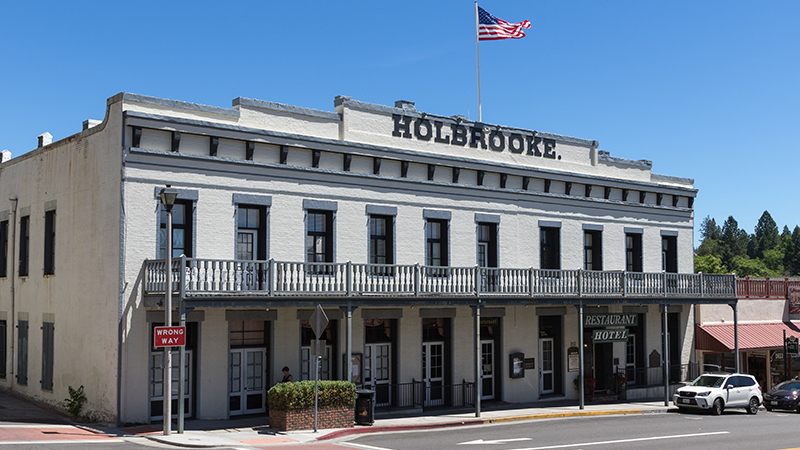
Grass Valley’s Holbrooke Hotel got its start as the Golden Gate Saloon, which opened in 1852 amidst California’s Gold Rush. That same year, the single-story Exchange Hotel was added to the same property as the saloon, though a fire destroyed both buildings just three years later. After reconstruction, another fire destroyed the hotel in 1862. This time, the hotel was rebuilt with iron doors and a fortified roof to prevent further damage from an inferno. In 1879, Ellen and Daniel Holbrooke bought the property and renamed it the Holbrooke Hotel. Since then, several famous guests have booked overnight stays, including Ulysses S. Grant, Grover Cleveland, James Garfield, and Mark Twain.
Colorado: The Cliff House at Pikes Peak (1874)
The Cliff House at Pikes Peak was opened in 1874 and was originally called The Inn. From the date of its founding to 1886, it was operated as a stagecoach stop on the road from Colorado Springs to Leadville before it was renovated to serve as a resort and spa offering treatments in the nearby mineral springs. In addition to Teddy Roosevelt, Charles Dickens, and Thomas Edison, Archduke Franz Ferdinand stayed at the hotel before his assassination in 1914.
Connecticut: 1754 House (1754)
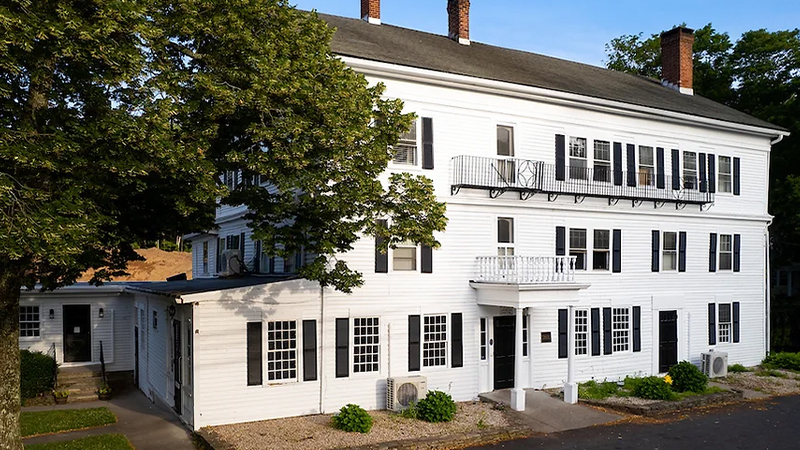
Woodbury’s 1754 House got its start in 1736 as a private residence for Connecticut local Anthony Stoddard. In 1754, the house was converted to an inn called the Curtiss House, which welcomed travelers for a hot meal and a place to stay. In 2020, the property’s current owners restored the inn and renamed it as a nod to its first year as a lodging facility. Today, there are seven guest rooms in the main house and four suites in the carriage house, as well as a restaurant, tavern, and parlor on the ground floor.
Delaware: Hotel duPont (1913)
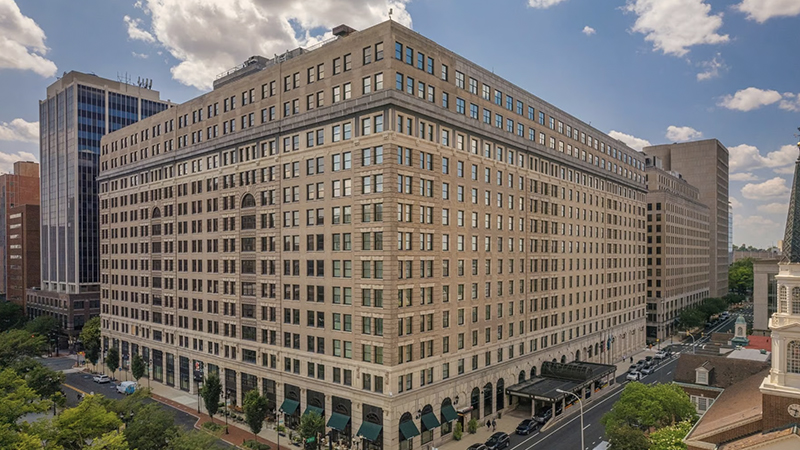
Wilmington’s Hotel duPont dates back to January 1913, when it was opened to rival some of Europe’s best hotels. The strategy worked: In the first week of operations, a whopping 25,000 visitors toured the 12-story hotel, which is home to 150 rooms, ballrooms, and restaurants. The hotel has been part of the Historic Hotels of America program since it was founded in 1989.
District of Columbia: Willard InterContinental Washington, D.C. Hotel (1818)
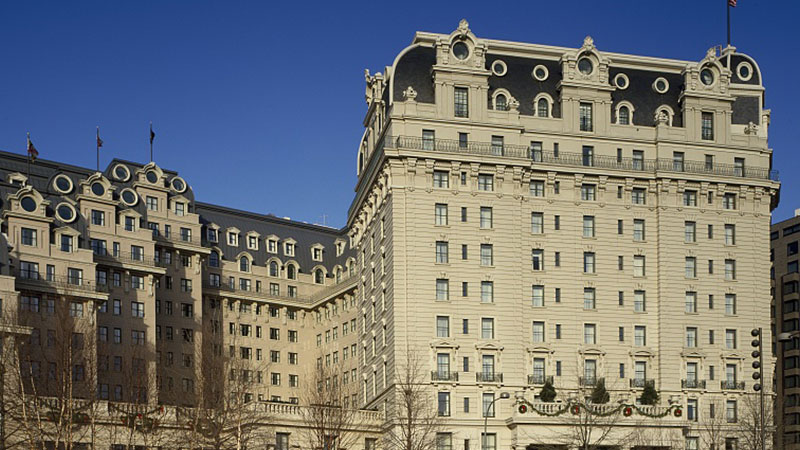
Located just across the street from the White House, the Willard InterContinental Washington, D.C. hotel is one of the most historic hotels in the country, having hosted numerous presidents thanks to its convenient location. Originally called Tennison’s Hotel, the property opened in 1818, though its name was changed to Willard’s City Hotel in the 1850s. Just over a century later, Martin Luther King Jr. sat in the hotel’s lobby and wrote the final draft of his “I Have a Dream” speech. Though it was vacant from the mid-1970s to 1986, the hotel reopened under its current name following extensive renovations and a management agreement with the InterContinental Hotels Group. Another milestone: The Mint Julep was introduced there in the 1830s.
Florida: The Florida House Inn (1857)
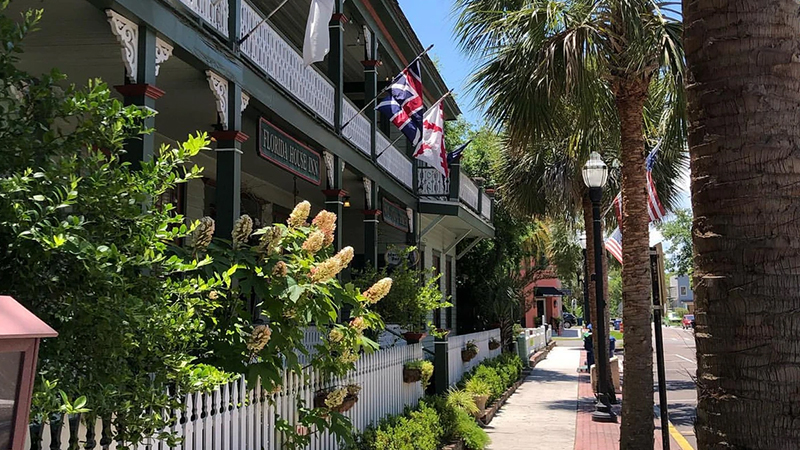
First constructed in the early 1850s as a lodging house, the Florida House Inn is located in the Fernandina Beach historic district. The hotel was temporarily closed during the Civil War to house Union soldiers, and on reopening, it hosted prolific families like the Carnegies, duPonts, and Vanderbilts. The property is rumored to be haunted by spirits, including a man with a mustache and a woman who fancies hopping into bed with men while yelling at their respective wives.
Georgia: The Marshall House (1851)
There are many historic hotels in Georgia, but unlike most of them, the Marshall House has been a hotel since its beginning in 1851. Located on Broughton Street in Savannah, The Marshall House also housed patients of the yellow fever epidemic and injured Union soldiers at the end of the Civil War. The property was closed in 1957 due to economic struggles and structural damage, though it was restored to its former glory in 1999 and reopened to the public.
Hawaii: Moana Surfrider, A Westin Resort & Spa (1901)
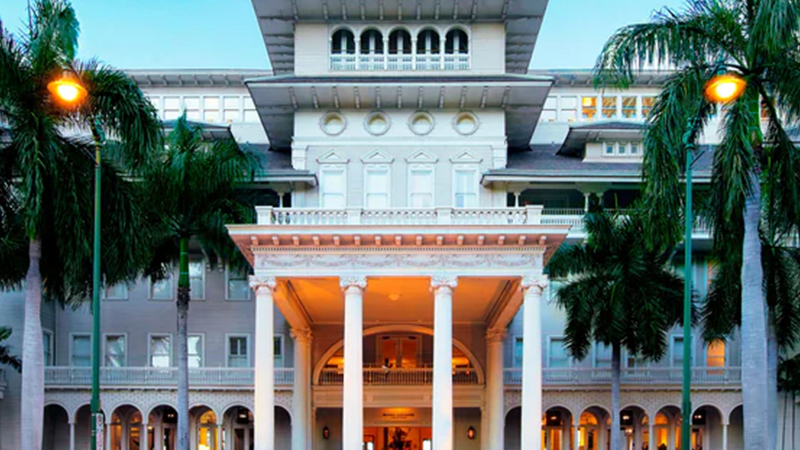
The Moana Surfrider, originally named the Moana Hotel, first opened its doors in Honolulu’s Waikiki neighborhood on the island of Oahu in March 1901. After the bombing of Pearl Harbor, the property was converted to a recreation area for soldiers fighting in World War II. In 1952, when tourism had resumed on the island, a new hotel called the Surfrider Hotel was built just a few meters away from the Moana Hotel. Seventeen years later, the Sheraton hotel group purchased the Moana Hotel and constructed a new tower also dubbed the Surfrider. In 1989, a multi-million-dollar renovation combined all the properties into one building under its current name.
Idaho: The Idaho Hotel (1863)
Silver City was once a booming mining town during the gold and silver rushes of the 1800s. Established in 1863, the Idaho Hotel housed miners and visitors passing through town, though it closed in 1942 due to the lack of traffic. While preservationists reopened the property in 1972, it remains relatively stuck in time. As Silver City is now considered a ghost town, the electricity is purely solar-powered. Inside, you’ll find no televisions or outlets, and only 13 of its rooms are heated.
Illinois: The DeSoto House Hotel (1855)
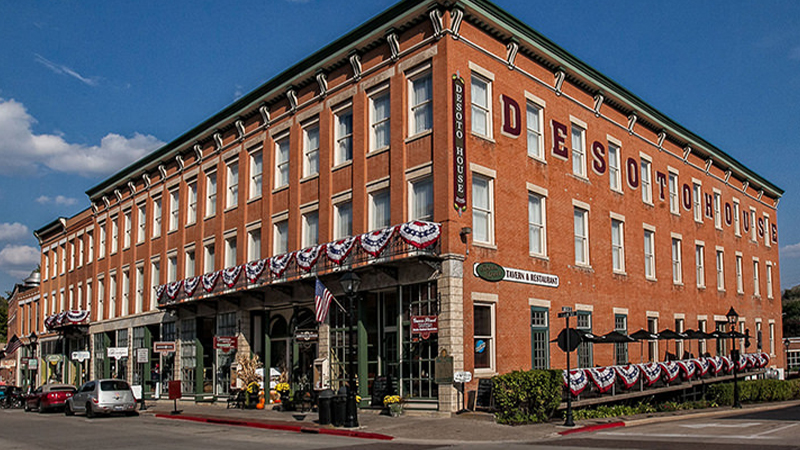
The DeSoto House opened in Gelena in 1855 following a population boom spurred by the construction of the Illinois Central Railroad. Referred to as the “largest hotel in the west” when it was founded, the hotel has hosted presidents including Ulysses S. Grant and Abraham Lincoln. The hotel currently holds 55 rooms, dining areas, a ballroom, and banquet rooms.
Indiana: French Lick Springs Hotel (1845)
Established in 1845, French Lick Springs Hotel opened its spa in 1901 and made a name for itself as a luxurious health facility utilizing the nearby mineral springs for treatments. Prominent guests have included Harry Truman, Ronald Regan, Bing Crosby, Louis Armstrong, and numerous pro golfers who have taken advantage of the nearby The Hill Course.
Iowa: Hotel Julien Dubuque (1839)
Opened as the Waples House in 1839, the Hotel Julien Dubuque is located in downtown Dubuque and was originally known as one of the nicest hotels in the Midwest. In addition to hosting Buffalo Bill, Mark Twain, and Abraham Lincoln, the property is also inextricably linked to Al Capone. Rumor has it that Capone would take up residence in the hotel whenever he felt pressure from Chicago authorities, hiding his cars in an underground parking garage nearby. And while there’s no paper trail confirming this, some argue that the gangster once owned the hotel.
Kansas: Historic Elgin Hotel (1886)
The Historic Elgin Hotel in Marion opened in September 1886 following a commission to stimulate the town’s economic growth. In the 1950s, the hotel served a prominent purpose as a gathering place for lease agents and drilling promoters during the oil boom, though it fell into disrepair and shuttered its doors in 1967. The hotel was converted into apartments in 1977, and it remained that way until 2006 when Jim and Nancy Cloutier purchased the building and reopened it three years later as a bed and breakfast. Today, the hotel is home to private rooms, a restaurant and bar, fitness center, and game lounge.
Kentucky: Old Talbott Tavern (1779)
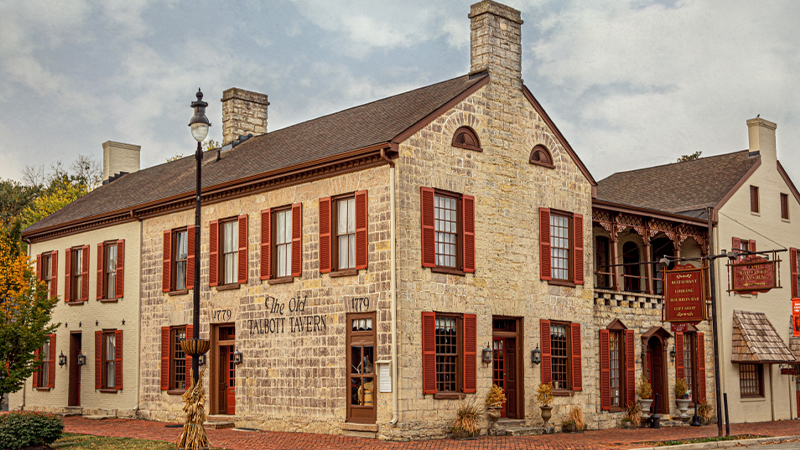
Situated in the heart of bourbon country, Bardstown’s Old Talbott Tavern has been referred to as America’s oldest stagecoach tavern, dating all the way back to 1779. Home to the world’s oldest bourbon bar, the hotel has six rooms, each named after historic visitors including Jesse James, General Patton, and Abraham Lincoln. With such a lengthy history, it’s no surprise that the property is rumored to be haunted. Over the decades, guests have reported seeing flashes of light, having personal belongings move on their own accord, and seeing ghostly apparitions. The Discovery Channel even claims to have captured the image of a Union soldier who lost both legs dragging himself down one of the hotel’s hallways.
Louisiana: Omni Royal Orleans (1838)
Built in New Orleans’ French Quarter in 1838 to rival the St. Charles Hotel, Omni Royal Orleans (originally dubbed the St. Louis Hotel) has an extremely tumultuous history: In the early 1830s, the property served as a major hub for the American slave trade. Three years after its opening, a fire destroyed the hotel, and it was rebuilt a short time later. After New Orleans was taken over by the Union during the Civil War in 1862, the hotel was converted to a medical facility for injured soldiers. After the war, the hotel did not regain its footing until the 1960s. Two decades later, it was acquired by Omni Hotels and Resorts and renamed the Omni Royal Orleans.
Maine: Seaside Inn (1660)
The Seaside Inn in Kennebunk, situated right on the coastline, is one of the oldest family-run businesses in the U.S., currently in its ninth generation of ownership. Trish Mason’s family has been keepers of the inn since 1756, though evidence of an inn on the property dates as far back as 1660. The Seaside currently offers just over 20 rooms, a number of which have pristine ocean views.
Maryland: Historic Hotels of Annapolis (1727)
The Historic Hotels of Annapolis comprises three boutique hotels: the Governor Calvert House, the Robert Johnson House, and The Maryland Inn. The Governor Calvert House is the oldest of the bunch, dating back to 1727, while the latter two were constructed in 1773 and 1776, respectively.
Massachusetts: Concord’s Colonial Inn (1716)
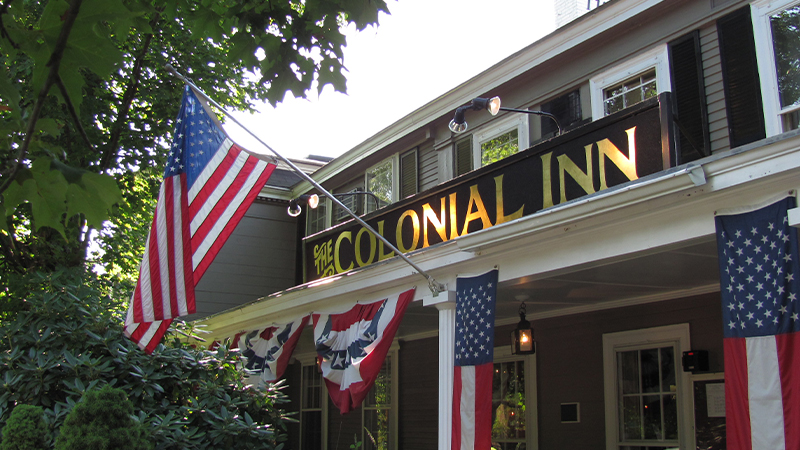
While Stockbride’s Red Lion Inn (opened in 1773) may be the longest continually operating hotel in Massachusetts, Concord’s Colonial Inn predates the opening by several decades. Constructed in 1716, the inn was originally operated as such, though was used as a storage facility for food and weapons during the Revolutionary War and served as an inn and private residence in the 1800s. Henry David Thoreau even lived there while attending Harvard University. In 1889, the property was fully converted back to an inn and was renamed Concord’s Colonial Inn in 1900.
Michigan: National House Inn (1835)
Predating Michigan’s statehood by two years, Marshall’s National House Inn opened in 1835. At the time, it was a popular place for travelers on their way to Chicago to stop for the night, though it was forced to close in 1878 following the distracting inventions of dining cars and Pullman sleepers. For the last few decades of the 1800s, the property served as a factory producing windmills and farm wagons, though it was converted into eight apartments after it was purchased by a veterinarian in 1902. It fell into disrepair a short time later and sat vacant until the 1970s, when it was purchased by Norm and Kathy Kinney and reopened on Thanksgiving in 1976.
Minnesota: Anderson House Hotel (1856)
Built in Wabasha just a block from the Mississippi River in 1856, the Anderson House Hotel is one of the most peculiar properties on this list. The hotel first gained popularity for the cats guests were able to check out and bring to their rooms during their stays. While the hotel briefly closed in 2009, it was reopened in 2011 under new ownership. Sadly, there are no rentable cats there today.
Mississippi: The Belmont 1857 (1857)
Built in 1857, The Belmont has served a number of purposes in its tenure, including a private residence, a hunting lodge for sportsmen, and now a bed and breakfast. Built on a plantation, the house has a brutal past.
Missouri: Elm’s Hotel & Spa (1888)
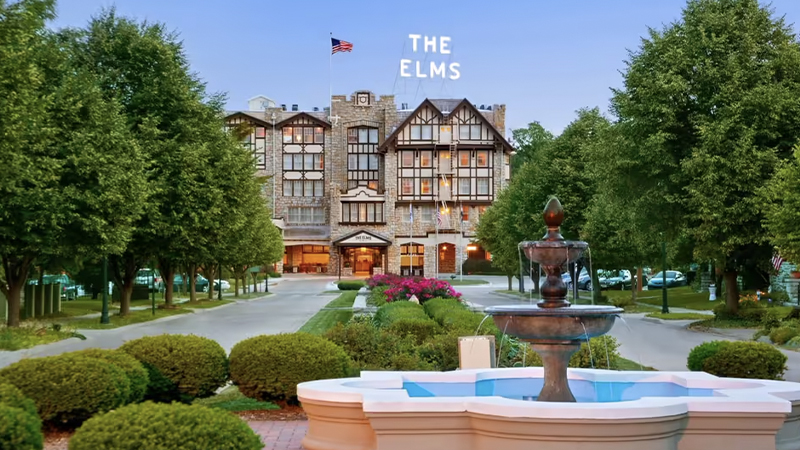
Kansas City’s Elm’s Hotel & Spa is not only the oldest hotel in Missouri, but it’s also one of the state’s most haunted places. Opened in 1888, the property almost immediately gained attention for its lavish spas capitalizing on the area’s mineral water baths. But just one year after opening, a fire destroyed the entire property. After reconstruction finished in 1909, a second fire tore the structure down the following year. The present-day Elm’s Hotel & Spa was completed in 1912, and has since hosted prominent guests including Harry Truman, Al Capone, and gambler Bugsy Morgan. For modern-day guests interested in the property’s paranormal history, the hotel offers a paranormal package delving into all aspects of its spooky past.
Montana: Grand Union Hotel (1882)
The Grand Union Hotel in Fort Benton was opened in 1882 and was referred to at the time as the “Waldorf of the West.” The hotel was at peak popularity in the steamboat era, but it lost favor once the Northern Pacific Transcontinental Line was established. The three-story hotel was renovated in 1999 and has remained the same since.
Nebraska: Historic Argo Hotel (1912)
When the Historic Argo Hotel opened in 1912, it was intended to be a place for travelers to get some rest while moving west on the nearby railroad. In 1935, the property was transformed into a sanatorium, and later, a doctor’s office. Under new ownership, the building was converted back into a bed and breakfast in 1994, though ghosts of its past remained. The B&B is rumored to be haunted by a few spirits, the most famous of which is a woman named Alice who reportedly searches the hotel for her lost child.
Nevada: Gold Hill Hotel (1861)
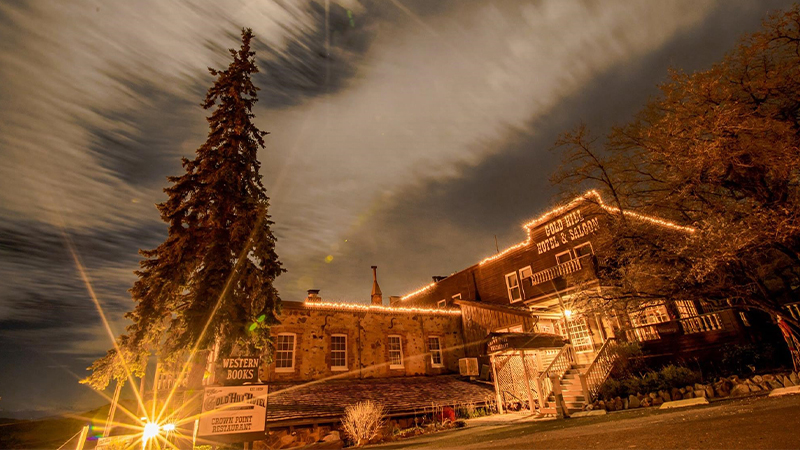
Tucked away in Virginia City, the Gold Hill Hotel has been welcoming guests since 1861. In its heyday, Virginia City was one of the most famous cities in the West due to a booming silver strike to its north. Today, a few of the hotel’s original rooms can be rented out, though more modern accommodations also exist. The property is believed to be haunted by numerous spirits who may have died during the Yellow Jacket mine collapse of 1869, which killed 35 people. The most famous ghosts include Rose and William, who have been spotted in the rooms aptly named after them.
New Hampshire: Thayers Inn (1850)
Opened in 1850, Littleton’s Thayers Inn has hosted presidents such as Ulysses S. Grant, Franklin Pierce, Richard Nixon, Jimmy Carter, and George H.W. Bush. Located along Main Street, the hotel is a prominent fixture of the community and boasts 25 rooms to host overnight guests.
New Jersey: Congress Hall Hotel (1816)
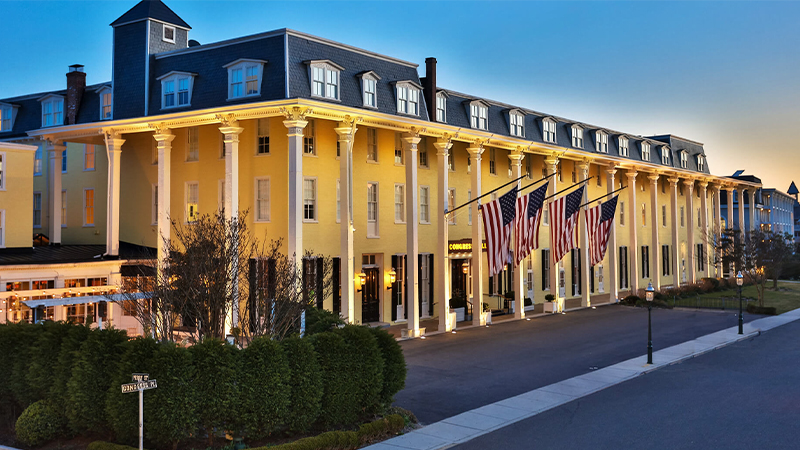
Located in Cape May, New Jersey’s southernmost barrier island, Congress Hall was constructed in 1816 as a place for seashore visitors to spend the summer. The towering building, originally owned by Thomas H. Hughes, was nicknamed “Tommy’s Folly” due to the locals’ belief that the hotel would never be a success. The hotel has changed hands a number of times in its 208-year history, and is currently also home to a number of shops, restaurants, and even a nightclub.
New Mexico: La Fonda on the Plaza (1607)
While the Santa Fe structure known today as La Fonda opened its doors 1922, there has been a hotel on the property since the city’s founding in 1607. The original inn opened in the early 1600s and for the first 200 years of its existence, it was a crucial stopping place for those venturing along the El Camino Real de Tierra Adentro. In the 1800s, it was also one of the best places to stay for those forging the Sante Fe Trail. Like many hotels on this list, the original building burned down, though it was reconstructed and reopened in the 1920s. The La Fonda of the present day was refurbished in 2007 and is currently a member of Historic Hotels of America.
New York: Beekman Arms & Delamater Inn (1766)
Dating back to 1766, the Beekman Arms & Delamater Inn is located in Rhinebeck, approximately 100 miles north of New York City. The property was established in 1704 by William Traphagen as a tavern, though the Beekman Arms was added in the 1760s, transforming the location into a hotel. The property was beloved by F.D.R., who was a frequent visitor during his tenure as governor and president.
North Carolina: NuWray Hotel (1833)
Burnsville’s NuWray Hotel, established in 1833, was North Carolina’s longest continuously operating hotel until it was temporarily closed for extensive renovations in 2023. The hotel will reopen this summer, and in its lengthy history, the property has hosted famous guests including Elvis Presley and Jimmy Carter.
North Dakota: Rough Riders Hotel (1884)
When the Rough Riders Hotel opened in Medora in 1884, it was called The Metropolitan. But in 1905, following Theodore Roosevelt’s first term, it was renamed to pay homage to the volunteer-only cavalry unit led by the former president. The hotel houses 68 modern guest rooms, eight historic rooms, and a private library containing 1,100 volumes of Roosevelt’s writing.
Ohio: The Golden Lamb Restaurant & Hotel (1803)
Lebanon’s Golden Lamb Restaurant & Hotel first opened its doors in 1803, making it Ohio’s longest continuously operating business. The hotel has hosted overnight stays for 12 U.S. presidents in addition to prolific authors like Charles Dickens, Harriet Beecher Stowe, and Mark Twain. Similar to many other hotels on this list, the Golden Lamb is rumored to be haunted, with guests reporting an angry spirit in “Sarah’s Room” having loud tantrums that can be heard from the floor below.
Oklahoma: The Skirvin Hilton (1911)
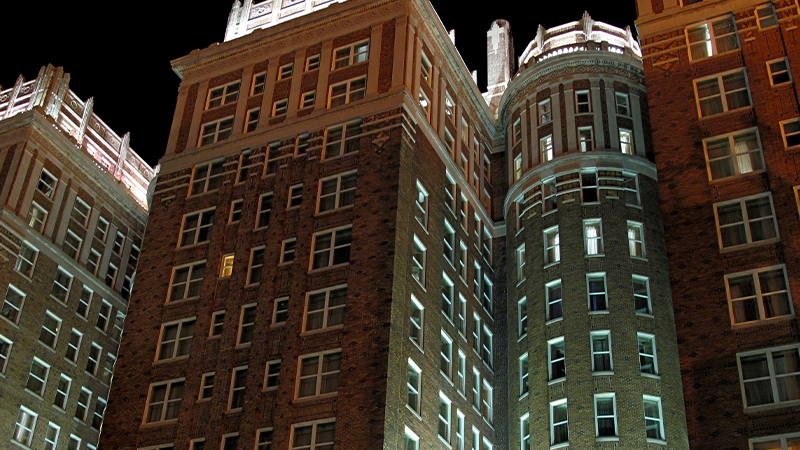
Standing at 13 stories high is the Skirvin Hilton in downtown Oklahoma City, which has been operational since 1911 when it opened as The Skirvin. The hotel has changed hands throughout the past century, most recently the 2007 acquisition by Hilton, which pumped $50 million of renovations into the historic property. In the 2010s, several NBA teams stayed at the hotel while playing in Oklahoma City, several of which have cited ghostly happenings.
Oregon: Wolf Creek Inn (1883)
Built in 1883, the Wolf Creek Inn has been operational since its opening. At its start, the hotel was an important fixture on the stagecoach trail connecting San Francisco and Portland. The hotel was purchased by the Oregon Parks and Recreation Department in 1975, which invested several million dollars into the property during a four-year renovation to restore the Wolf Creek to its former glory.
Pennsylvania: The Gettysburg Hotel (1797)
Just a short walk from the Gettysburg battlefield is the Gettysburg Hotel, which has offered overnight accommodations since 1797 when James Scott opened Scott’s Tavern on the property. The 9,000-square-foot hotel is home to 119 guest rooms, which are purported to be haunted by Civil War-era spirits who lost their lives during the Battle of Gettysburg.
Rhode Island: Graduate Providence (1922)
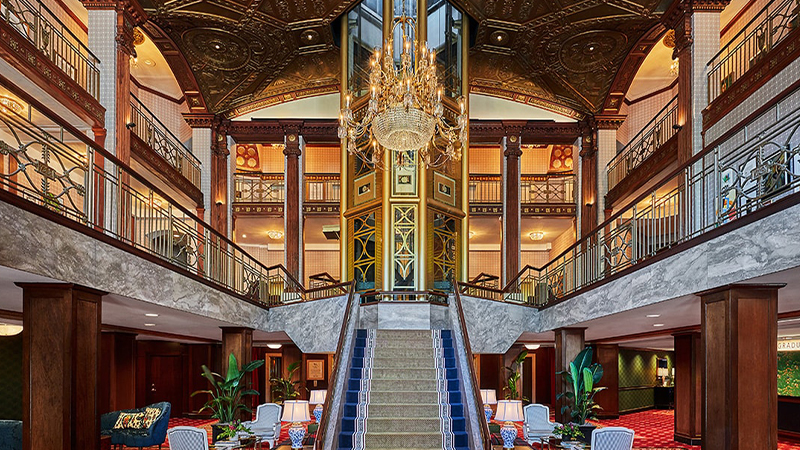
Designed by the same team of architects who designed New York City’s Grand Central Station, the Graduate Providence (originally known as the Providence Biltmore Hotel) opened in 1922. The 19-story hotel was financed by Johan Leisse Weisskopf, a Satanist rumored to have wished the property would be used to educate the public on his religion. The building is also reportedly haunted by Great Depression-era ghosts. The property was added to the National Register of Historic Places in 1977 and was renamed the Graduate Providence in 2019.
South Carolina: Francis Marion Hotel (1924)
Opened in 1924, the Francis Marion Hotel is located in Charleston’s historic district and is named after the Revolutionary War general considered to be one of the founders of guerilla warfare. The hotel attracted many members of the elite throughout the 20th century before falling into decline at the tail end. But in the mid-’90s, the hotel received a $12 million boost from the National Trust for Historic Preservation, which restored the building to its former glory.
South Dakota: Historic Bullock Hotel (1896)
The Historic Bullock Hotel was built and opened by politician, sheriff, and U.S. Marshall Seth Bullock in 1896. The two-story building houses 28 guest rooms, a bar, and a casino, all of which are supposedly haunted by Bullock himself, who has been said to turn showers on and off and move items when staff isn’t paying attention.
Tennessee: Hale Springs Inn (1824)
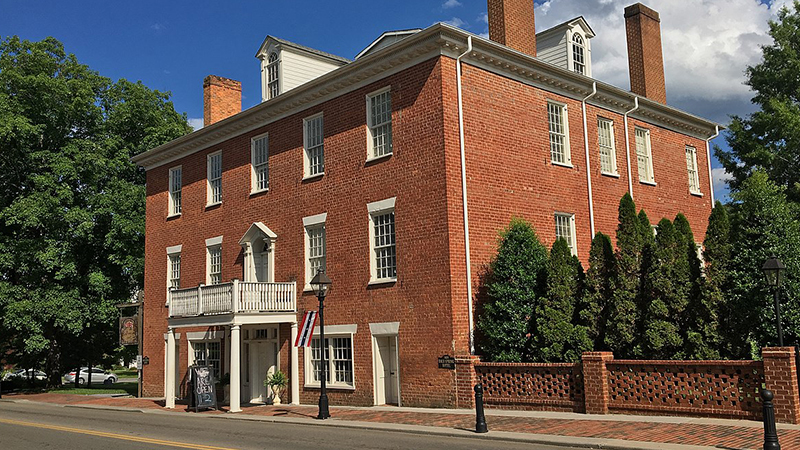
Built by John A. McKinney, the Hale Springs Inn was opened in Rogersville in 1824, making it Tennessee’s longest operating hotel. The nine-room hotel has three presidential suites, each of which is named after the politicians who have visited the property: James K. Polk, Andrew Johnson, and Andrew Jackson. Today, the inn is a popular wedding venue as well as tourist destination for avid historians.
Texas: The Excelsior House Hotel (1858)
Ulysses S. Grant, Rutherford B. Hayes, Lady Bird Johnson, Oscar Wilde, and Steven Spielberg have all stayed the night at Jefferson’s Excelsior House Hotel, which was opened in 1858. The property, which is operated as a not-for-profit hotel, is on the National Register of Historic Places and is said to be exceedingly haunted — especially room 215.
Utah: Moore’s Old Pine Inn (1882)
Moore’s Old Pine Inn, founded as the Pines Hotel, is the oldest-running hotel or inn in the state of Utah. Located in Marysvale, the property opened in 1882 and was favored by numerous historical figures including Butch Cassidy. The hotel was renovated from 1993 to 1995, though New York Times newspapers from 1882 are still glued to the ceiling’s rafters.
Vermont: The Dorset Inn (1796)
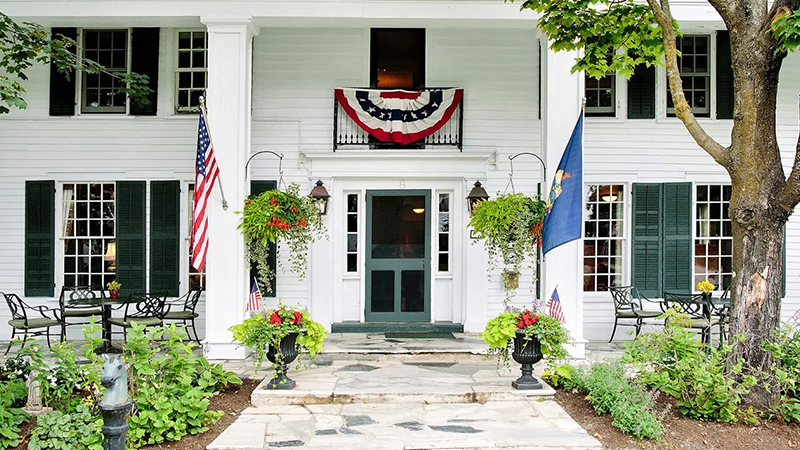
Located along the path from Boston to Albany, the Dorset Inn has been hosting overnight guests since 1796. Originally called the Washington Hotel, the inn’s architecture was inspired by George Washington’s family home, though in its 228-year run, the building has been expanded, renovated, and refurbished. Today, the property is home to 26 guest rooms, three suites, and a restaurant.
Virginia: The Omni Homestead Resort (1766)
The Omni Homestead Resort dates all the way back to 1764 when Captain Thomas Bullitt and Charles and Andrew Lewis received a 300-acre land grant. The three, along with their compatriots, moved to the land and constructed a log hotel called The Homestead, which opened in 1766. Located near mineral springs, the property attracted prominent figures including F.D.R., Dwight Eisenhower, J.F.K., Ronald Regan, and Thomas Jefferson, who sought a treatment for his rheumatoid arthritis. The property was purchased by the Omni Hotels and Resorts group in 2013.
Washington: The Tokeland Hotel (1885)
Right off the coast of the Willapa Bay, Tokeland, Wash.’s Tokeland Hotel has been welcoming guests since 1885. With such a lengthy history, it’s no surprise that the hotel is rumored to be haunted by both human and animal spirits. Former guests have reported seeing the apparition of a man wandering the halls as well as the figure of a cat walking across their beds before disappearing into thin air.
West Virginia: The Greenbrier (1778)
Sprawling across 11,000 acres of land is The Greenbrier resort in White Sulphur Springs. The original resort opened its doors in 1778 and attracted patrons with its proximity to natural sulfur springs, which are rumored to have healing properties. The structure on the property today dates back to 1858, though it has been continually built up over the years and now houses a whopping 710 guest rooms, 20 restaurants and lounges, and over 30 retail stores.
Wisconsin: The Pfister Hotel (1893)
First known as the Grand Hotel of the West, the Pfister Hotel opened in Milwaukee in 1893 as one of the first properties to have electricity throughout it. The interior, three-story hotel lobby has been meticulously kept up over the years and has maintained its original grandeur. Today, the hotel houses 307 guest rooms.
Wyoming: The Historic Occidental Hotel (1880)
The Historic Occidental Hotel is situated right at the base of the Bighorn Mountains in Buffalo, which made it an attractive stopping point for those traveling along the Bozeman Trail when it opened in 1880. In the late 19th and early 20th centuries, the hotel was visited by Butch Cassidy and the Sundance Kid, Buffalo Bill Cody, and Teddy Roosevelt. Despite changing hands and being renovated numerous times, the hotel has retained its 1800s, Old West charm.
![The Oldest Hotel in Every State [MAP] The Oldest Hotel in Every State [MAP]](https://vinepair.com/wp-content/uploads/2024/05/the-oldest-hotel-in-every-state-infographic-hotel-card-375x450.jpg)
![The Oldest Hotel in Every State [MAP]](https://vinepair.com/wp-content/uploads/2024/06/the-oldest-hotel-in-every-state-v8.png)